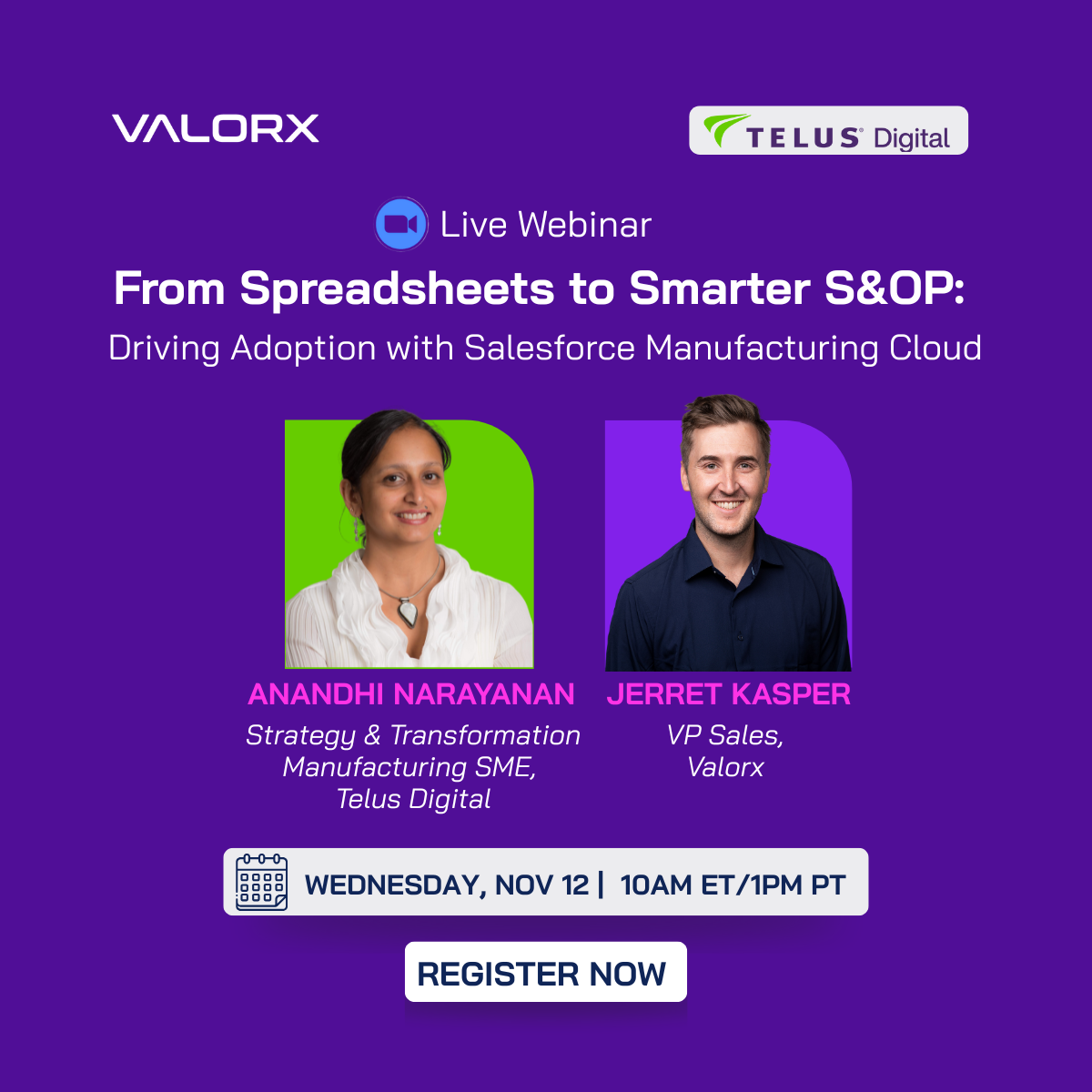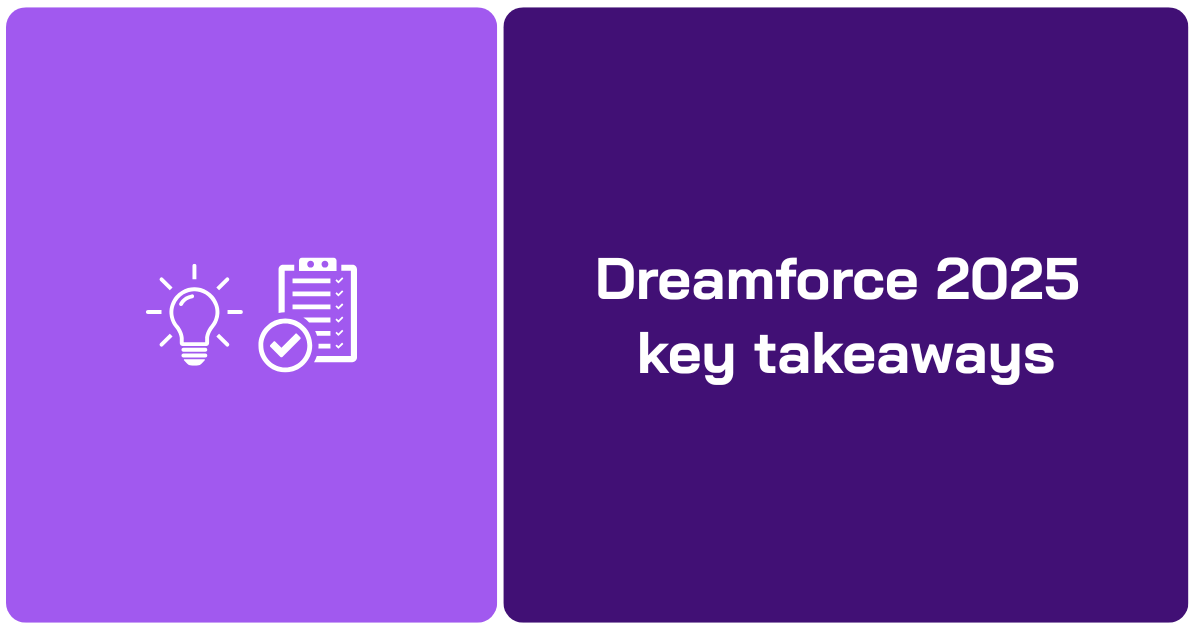“This is a revolution. Humans and agents working together in harmony.”
Marc Benioff, CEO, Salesforce
Dreamforce 2025 wasn’t just a conference — it was a reality check for how teams are actually using Salesforce today.

The Valorx team was on the ground, listening to customers and connecting with partners. Here are our top takeaways from Dreamforce 2025 — and how teams are solving the friction that still slows down day-to-day work.
Dreamforce 2025 takeaways at a glance.

1️⃣ Forecasting is a competitive differentiator — not a back-office task
Dreamforce made it loud and clear: forecasting is still one of the biggest pain points for enterprise teams. Siloed data, spreadsheet workarounds, and brittle planning tools are holding companies back — especially in industries like manufacturing, where agility and precision matter most.
What we’re seeing: Leadership teams want forecasts they can trust and act on — not just pretty dashboards. But when data lives in disconnected systems, agility suffers.
How forward-thinking teams are solving it: By merging the best of both worlds — Salesforce governance with spreadsheet-native modeling — teams are building real-time forecasting environments that adapt as fast as markets shift.
Tools like Valorx for Forecasting enable users to model, adjust, and approve forecasts directly in Salesforce, utilizing interfaces that resemble Excel but are fully auditable and secure.
2️⃣ CPQ still slows teams down — and spreadsheets aren’t going away
CPQ came up again and again at Dreamforce —
often in frustration. Complex quoting scenarios, slow systems, and adoption challenges are forcing many sales teams to revert to offline spreadsheets, creating risk and friction across the quote-to-cash process.
What we’re seeing: Even with modern CPQ platforms, many teams still “go offline” to build quotes — slowing down deals and introducing errors.
What’s working instead: Bringing CPQ logic and live Salesforce data into the spreadsheet environment where teams are already comfortable.
With Valorx for CPQ, sales reps can configure, price, and quote in a fast, Excel-style interface — fully synced to Salesforce, complete with validations, approvals, and audit trails.
3️⃣ The future of Salesforce is collaborative and industry-specific
Salesforce continues to double down on industry-specific clouds — and Manufacturing Cloud saw major upgrades this year. From rebate management to territory planning and account-based collaboration, the platform is becoming more aligned to real-world manufacturing operations.
What we’re seeing: The Manufacturing Cloud is powerful — but complex. Getting value quickly still requires heavy lifting.
What leading teams are doing: Using tools that align spreadsheet-native workflows with Salesforce’s structured data model — to reduce time-to-value and boost adoption.
Fusion helps teams adopt Salesforce Industry Clouds faster by preserving their spreadsheet workflows — while ensuring everything runs on live CRM data with full governance.
For teams managing massive data volumes — like operations or supply chain — Valorx Wave allows bulk edits, inline filtering, and rapid data updates right inside Salesforce. No toggling. No workarounds.
4️⃣ Automation is overhyped. Adoption is underrated.
One of the most candid themes at Dreamforce: automation only works when people use the systems it's built on. If teams avoid Salesforce because it’s slow, clunky, or unfamiliar, even the best automation can’t deliver ROI.
What we’re seeing: Many organizations are still struggling with the basics — clean data, consistent use, and intuitive workflows.
What actually works: Making Salesforce feel native — fast, familiar, and flexible. That means putting the user experience first, not just the process.
Tools like Fusion and Wave help companies increase CRM adoption by aligning workflows to how people already work — making data entry, planning, and updates faster and less painful.
5️⃣ Salesforce is all-in on agentic AI — but control still matters
While AI and automation got plenty of airtime, the most resonant message from customers and partners was this: in high-stakes workflows — like quoting, forecasting, and financial planning — governance matters more than hype.
What we’re seeing: Enterprises want innovation with accountability — not just flashy features.
What’s working: Solutions that combine flexibility with robust audit trails, permissions, and compliance built-in.
Fusion for Forecasting and Fusion for CPQ give frontline teams the speed of Excel with the trust of Salesforce — enabling high-performance workflows with enterprise-level control.
What’s next for the Salesforce ecosystem and what to expect in Dreamforce 2026?
If Dreamforce 2025 proved anything, it’s that teams don’t need more tools — they need better ways to make their existing tools work smarter.
That’s the philosophy behind Fusion and why we’re doubling down with Wave — built for the frontline user who needs to move fast without breaking the system.
With inline editing, real-time validation, and spreadsheet-style grids that live inside Salesforce, Wave eliminates slow, manual updates and replaces them with intuitive, high-speed workflows.
We’re already looking ahead to Dreamforce 2026, happening September 15–17, 2026, in San Francisco. But the time to act on the Dreamforce 2025 takeaways is now. The teams that start optimizing today will arrive at Dreamforce 2026 with momentum — not playing catch-up.
Curious how these Dreamforce 2025 takeaways apply to your team’s workflow?

FAQs
Q1. What are the key themes from Dreamforce 2025 takeaways?
The major Dreamforce 2025 takeaways include forecasting becoming a competitive advantage, CPQ friction, growth of industry clouds, adoption-first system thinking, and how agentic AI is maturing under stricter governance.
Q. Why does Dreamforce 2026 matter and how should teams prepare?
A. Dreamforce 2026 matters because it will build on the momentum of the Dreamforce 2025 takeaways. Teams should use the insights from Dreamforce 2025 takeaways to shape their roadmap now — streamline forecasting, rethink quoting, focus on adoption, ready their data, and start building governance for AI. Preparing now means arriving at Dreamforce 2026 ready to engage rather than playing catch‑up.
Q. How should manufacturing or industry‑specific teams act on these Dreamforce 2025 takeaways?
A. Industry teams should map each of the Dreamforce 2025 takeaways to their current process: review how forecasting and CPQ are performed, assess user adoption and data flows, evaluate where agentic AI fits (and where governance must be in place), and inspect where data‑volume or speed issues are slowing updates. Then frame a 90‑day plan before Dreamforce 2026 to pilot improvements.
Q. What is the role of AI agents and how does governance affect adoption?
A. From the Dreamforce 2025 takeaways, we learned that AI agents (like those in Agentforce) aren’t plug‑and‑play for enterprises — governance, audit trails, and user trust are critical. Adoption depends on controlling outcomes, managing permissions, and aligning agents with business logic. Failure to do so undermines both trust and value.
Q. What should be the first step for a team acting on the Dreamforce 2025 takeaways?
A. The first step is an internal assessment: identify which of the Dreamforce 2025 takeaways is most painful in your organisation today (forecasting, CPQ, adoption, data scale, etc.). Then prioritise a small high‑impact, fast‑win initiative. Use that momentum to build credibility ahead of Dreamforce 2026.
Let’s keep the conversation going...
We spoke about this at Dreamforce 2025, and we’re continuing the conversation in our upcoming webinar.
📅 From Spreadsheets to Smarter S&OP: Driving Adoption with Salesforce Manufacturing Cloud
🗓 Wednesday, November 12 | 🕙 10AM ET / 1PM PT
🎙 Featuring: Anandhi Narayanan (Telus Digital) & Jerret Kasper (Valorx)

Learn...
✅ How manufacturers can achieve more accurate Sales & Operations Planning (S&OP)
✅ How to combine Manufacturing Cloud with Valorx’s familiar Excel and Grid UI inside Salesforce
✅ How to make Salesforce adoption seamless, usage consistent, and decision-making faster


